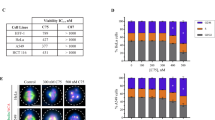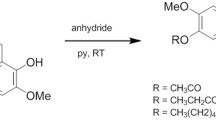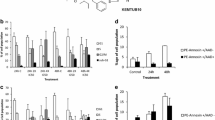Abstract
Purpose: Hemiasterlin, hemiasterlin A and hemiasterlin B are newly isolated cytotoxic tripeptides with potential as antitumor drugs. We wished to determine their mechanism of cytotoxicity. Methods: We studied their effect on cell survival, cell cycle progression, and microtubule morphology in MCF-7 human mammary carcinoma cells. Results: At the nanomolar concentrations at which they were cytotoxic, the peptides induced arrest in mitotic metaphase. Hemiasterlin A produced abnormal mitotic spindles like those produced by the microtubule inhibitors taxol, nocodazole and vinblastine at low concentrations. At high concentrations hemiasterlin A did not cause microtubule bundling like taxol, but caused microtubule depolymerization like nocodazole and vinblastine. Conclusions: The hemiasterlins probably exert their cytotoxic effect by inhibiting spindle microtubule dynamics.
Similar content being viewed by others
Author information
Authors and Affiliations
Additional information
Received: 21 September 1995 / Accepted: 28 May 1996
Rights and permissions
About this article
Cite this article
Anderson, H., Coleman, J., Andersen, R. et al. Cytotoxic peptides hemiasterlin, hemiasterlin A and hemiasterlin B induce mitotic arrest and abnormal spindle formation. Cancer Chemother Pharmacol 39, 223–226 (1996). https://doi.org/10.1007/s002800050564
Issue Date:
DOI: https://doi.org/10.1007/s002800050564




